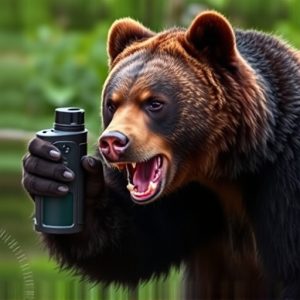Alaska Bear Spray Fog Pattern: Legalities, Safety & Alternatives
In Alaska, bear spray serves as an alternative defense mechanism for outdoor activities, deterring a…….
In Alaska, bear spray serves as an alternative defense mechanism for outdoor activities, deterring and temporarily incapacitating bears with its non-lethal fog pattern. Though not considered a restricted weapon state-wide, local regulations vary, with some areas imposing stricter rules. Effective use requires understanding the spray's range, mist pattern, and aiming for sensitive areas. While bear spray isn't foolproof, it complements knowledge of bear behavior, smart gear choices, and defensive techniques for safer adventures in bear country.
In Alaska’s rugged wilderness, encountering bears is a real possibility. Bear spray has emerged as a common defense mechanism, but understanding its fog pattern and effectiveness is crucial. This article delves into the intricacies of bear spray, exploring its fog pattern, legal considerations regarding its classification as a restricted weapon, usage guidelines, safety precautions, and alternative measures for ensuring safety in Alaska’s wild landscapes. By examining these aspects, you’ll gain insights to make informed decisions while navigating Alaska’s natural environment.
- Understanding Bear Spray: A Common Defense in Alaska
- The Fog Pattern: How Effective is It?
- Legal Considerations: Is Bear Spray a Restricted Weapon?
- Usage Guidelines and Safety Precautions
- Exploring Alternatives: Beyond Bear Spray for Safety in Alaska's Wilderness
Understanding Bear Spray: A Common Defense in Alaska
Bear spray, also known as bear repellent, is a common defense mechanism for individuals venturing into Alaska’s wild terrain. Unlike restricted weapons, bear spray is designed to deter and temporarily incapacitate bears rather than cause harm. It’s a crucial tool in navigating the state’s diverse landscape, especially when encountering aggressive or curious bears.
In Alaska, where grizzly and black bears are prevalent, carrying bear spray is often mandatory for outdoor activities like hiking, camping, and fishing. The fog pattern of modern bear sprays allows for a wide reach, enabling users to create a protective barrier from hungry or protective mothers. Understanding how and when to use bear spray effectively can significantly improve safety outcomes during encounters with these majestic yet potentially dangerous animals.
The Fog Pattern: How Effective is It?
The fog pattern, a unique delivery method used in bear spray, is designed to create a dense cloud of pepper spray, effectively blinding and disorienting potential bear attackers. This technique differs from traditional direct spraying, aiming to cover a larger area and reach bears at various distances. The effectiveness lies in its ability to create a barrier of spray that can slow down or deter aggressive bears without the need for direct contact.
While it may seem like an innovative approach, the fog pattern’s success depends on several factors. The terrain, wind conditions, and bear behavior all play crucial roles. Interestingly, many experts debate whether bear spray, including the fog variant, should be considered a weapon. Given its non-lethal nature, it offers a valuable tool for outdoor enthusiasts and residents in bear country to deter attacks without causing harm. However, understanding local regulations regarding bear spray is essential, as some regions have restrictions on its use and carry requirements, treating it more like a defense mechanism than a weapon.
Legal Considerations: Is Bear Spray a Restricted Weapon?
In many areas of Alaska, carrying bear spray is legal and recognized as a crucial tool for personal safety while hiking or camping in grizzly country. However, it’s important to understand the legal considerations surrounding bear spray, especially regarding its classification as a weapon. Bear spray is not considered a restricted weapon by the state of Alaska, allowing residents and visitors alike to legally possess and use it for defense against bears.
Despite this, local ordinances and regulations can vary, with some municipalities having stricter rules about the type, amount, and carrying of bear spray. It’s advisable to check with the local law enforcement agency or municipality before venturing into remote areas to ensure compliance with any specific restrictions. Additionally, understanding the legal definition of a “weapon” is essential, as some jurisdictions might have different criteria for what constitutes a legal defense tool.
Usage Guidelines and Safety Precautions
Bear spray, also known as bear deterrent or pepper spray, is a popular self-defense tool for those venturing into bear country. However, it’s essential to understand that bear spray is not a restricted weapon but rather a specialized form of personal protection designed to deter and disable aggressive bears temporarily. Usage guidelines vary by region, but generally, individuals are advised to carry bear spray while hiking, camping, or participating in outdoor activities in bear-inhabited areas.
Safety precautions should be prioritized when using bear spray. It’s crucial to understand the fog pattern and range of the spray. Bear spray creates a mist or fog that can reach up to 30 feet (9 meters) in ideal conditions. Users should aim for the face and eyes of the attacking bear, as these areas are sensitive. Practice and training are essential to ensure effective use during an encounter. Additionally, keep in mind that bear spray might not always be successful, and it’s crucial to back away slowly and consider other escape routes or defensive measures if a charge occurs.
Exploring Alternatives: Beyond Bear Spray for Safety in Alaska's Wilderness
In Alaska’s vast wilderness, ensuring safety while encountering bears is paramount. While bear spray is a popular and effective deterrent, it’s not the only option available to outdoor enthusiasts. Exploring alternatives can provide a more comprehensive approach to bear safety. For instance, knowledge of bear behavior and habitat can empower individuals to make informed decisions, such as choosing routes with minimal bear activity or carrying noise makers to startle bears at a distance.
Additionally, proper clothing and gear choices can offer protection. High-visibility apparel and loud, reflective items can alert bears to your presence, potentially avoiding unwanted interactions. Some even advocate for learning defensive techniques, allowing individuals to respond effectively if a bear charge occurs. It’s essential to remember that while these alternatives may not be as universally accessible or regulated as bear spray (which is often considered a restricted weapon), they contribute to a layered safety strategy for Alaska’s outdoor adventurers.
In conclusion, while bear spray is a popular and effective defense mechanism in Alaska’s wilderness, understanding its fog pattern, legal status as a restricted weapon, and safety precautions is paramount. Although it offers a valuable tool for personal safety, exploring alternatives can provide additional layers of protection. Knowing when and how to use bear spray responsibly, or considering alternative prevention methods, ensures a safer experience while navigating Alaska’s stunning yet unpredictable landscapes.


